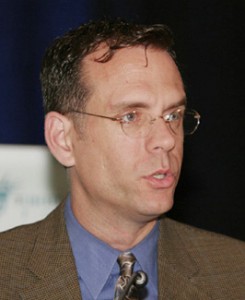OutRight: A New Anti-Gay Marriage Mantra
Deconstructing opponents’ arguments is tedious, but essential.
Opponents of gay marriage have tried a number of arguments, all of which have failed to end the progress
toward the recognition of gay relationships. Now they’re trying out a new one that ties gay marriage to a miasma of marital and familial decline.
Gay-marriage opponents first argued that same-sex couples could not be married because the definition of marriage is the union of a man and a woman. This worked as long as nobody thought very hard about the issue, but it fails as soon as you realize the whole argument is over what the definition should include.
Some gay-marriage opponents tried to frighten the public with negative stereotypes of gays. The problem is that too many Americans know actual gay people for this to have much effect anymore.
Next they warned that gay marriage would be the first step down a slippery slope toward things like polygamy. But this failed to catch on because there just aren’t that many people clamoring for 10-person marriages. Two is hard enough.
They moved on to children after that, warning that gay couples couldn’t do as good a job as a biological mother and father. This argument still has some life, but its power wanes when people realize that gay marriage won’t take children away from biological parents who want to raise them. And marriage would help the more than one million children now being raised by gay people.
Now, in a new book entitled The Future of Marriage, family and marriage scholar David Blankenhorn tries a new argument. He argues that support for gay marriage is part of a destructive “cluster” of “mutually reinforcing” beliefs about family life. He cites international surveys of attitudes about families and marriage showing that the presence of gay marriage in a country correlates with a series of beliefs that he describes as, roughly speaking, antimarriage.
For example, people in countries with gay marriage are more likely to agree with statements like, “One parent can bring up a child as well as two parents together,” or, “It is alright for a couple to live together without intending to get married.”
Conversely, people in countries with no recognition of gay relationships are more likely to agree with statements like, “Married people are generally happier than unmarried people,” or, “The main purpose of marriage these days is to have children.”
In other words, Blankenhorn notes that there is a correlation between nontraditional beliefs about marriage and support for gay marriage. He claims this allows us to “infer” a “likely causal relation” between gay marriage and antimarriage views.
What do we make of this latest antigay marriage argument? A correlation might indicate something important is going on. It’s a clue that two seemingly unrelated phenomena may be related.
But by itself a correlation doesn’t prove that one thing caused another. People who buy ashtrays are more likely to get lung cancer, but this doesn’t prove that buying ashtrays causes lung cancer. If we relied on correlation alone, we’d think all sorts of crazy things were causally related.
Consider what can be done with a correlation used to “infer” a “likely causal relation.” People in countries without same-sex marriage are more likely to believe women should stay at home and not work, that men should be masters of their households, that there should be no separation of church and state, that people should not use contraception when they have sex, and that divorce should never be permitted. If these correlations exist, have I demonstrated the existence of a “cluster of beliefs” that reinforce one another, undermining the arguments against
gay marriage?
Or consider the more sympathetic correlations to gay marriage that Blankenhorn ignores. Countries with same-sex marriage are richer, healthier, more democratic, more educated, and more respectful of individual rights. Have I shown that the absence of gay marriage is likely causing harm in those benighted countries that refuse to recognize it?
Here’s another correlation helpful to the case for gay marriage: Countries with gay marriage are enjoying higher marriage rates since they recognized it. Have I shown that gay marriage likely caused this?
Even Blankenhorn’s correlation is suspect. Nontraditional attitudes about marriage preceded the recognition of gay marriage in the countries that have it. How could gay marriage have caused a decline
in traditional marital attitudes before it even existed?
Of course, Blankenhorn is still free to argue that nontraditional attitudes greased the way for gay marriage, but this doesn’t show that it caused or even reinforced nontraditional attitudes. What Blankenhorn needs, even as a starting point, is some evidence that nontraditionalist views increased after gay marriage began. He doesn’t have that. Even if he did, such a rise might well only be a continuation of pre-existing trends.
And even if he had the sequence right, Blankenhorn would still have the problem
of trying to deal with the existence of multiple other things that have fueled nontra-
ditionalist attitudes. We can plausibly surmise that factors like increased income, longer life spans, more education, and women’s equality–rather than gay marriage–have led to nontraditionalist attitudes
about marriage.
Intellectual guilt-by-association has an easy appeal that may make Blankenhorn’s argument an antigay marriage mantra in the future. His superficially frightening correlations have to be carefully unpacked to show how misleading they are.
Writing from the conservative side, Dale Carpenter began his column for OutSmart in 1994, when he lived in Houston. Now residing in Minneapolis, Carpenter is a University of Minnesota Law School professor.











